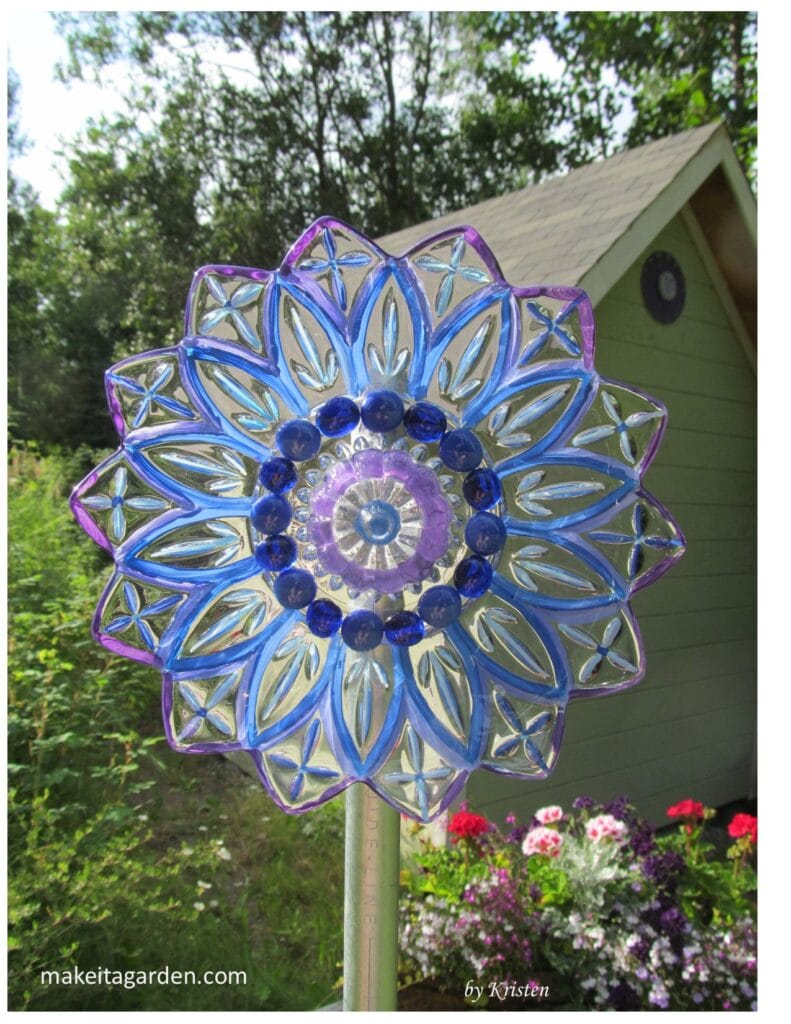
Sell Your Dish Flower Art Garden Art Series
So, you’re thinking about making and selling dish flowers? Maybe you’re still deciding whether you want to make them as gifts to family or friends or become a full-fledged crafting business. You came to the right place!
A brief introduction:
I’m Kristen, a craftsman who makes and sells my own garden art. You may enjoy taking a look at some of my creations HERE. This article is specifically geared to help you sell your dish flower art (and other glass garden art) as it has its own particular set of challenges.
When I first considered starting a crafting business, I had no concept of what was involved in selling dish flowers. I only hoped there was still a good market for them. If you’re going to sell something, that’s pretty important to know, right? But I found very little on the Internet about the art form except for some discussion on glue and assembly methods that dated back to the years 2008, 2010, 2012.
I had no concept of my customer profile; who my buyer was. And I wasted a lot of time and money doing shows that were not profitable. It certainly would have been helpful if I could have found more relevant information. Maybe I just didn’t use the right combination of keywords in my search, but that can be frustrating and time-consuming, too.
Granted, there is plenty of good information about craft shows in general. I viewed lots of You Tube videos. But much of it related to those making smaller hand-crafted items. How to decorate your booth, create eye-catching displays and other topics that just wasn’t applicable to selling large, fragile things like dish flowers.
So, I created this post as a resource that would address some of these things. More than that, it’s the desire to help fellow artisans, so you won’t have to flounder about as I did through all the trail and error.
Overview: sell your dish flower art
The following information is based on my own experience making and selling dish flowers, totems and other glass garden decor. I’ll go over some essential things that will help you plan and give you confidence.
We’ll cover the following:
- Why sell dish flower art?
- Is there a market for handmade garden art?
- Who buys dish flowers? Defining your audience
- Choosing the right craft show
- Best way to display dish flowers at craft shows
- What about the competition?
- Retail: consignment and wholesale
- social media
- business cards
Why sell your dish flower art?
For starters, I hope that you’re making and selling dish flowers because you love them. Not just because they are a trendy craft item. I say that because there are two schools of thought on selling crafts. On the practical side of things, some people advise researching what is hot and selling that. In recent years, for example, gnomes have been the big thing. There’s no question that this approach is profitable.
The other end of the spectrum has its merits, too. From an emotional standpoint, others advocate making and selling what you love. It doesn’t mean that what you love can’t be profitable. It simply means that you have a certain talent or enthusiasm for something you want to pour your whole heart into. I put myself in this camp.
When you make what you love, you tend to enjoy the creative process and find it stimulating. Unlike other crafts, dish flowers are unique in that nothing is rubber-stamped. You won’t get bored as you might with an ‘assembly line’ production making hundreds of an item that all look the same.
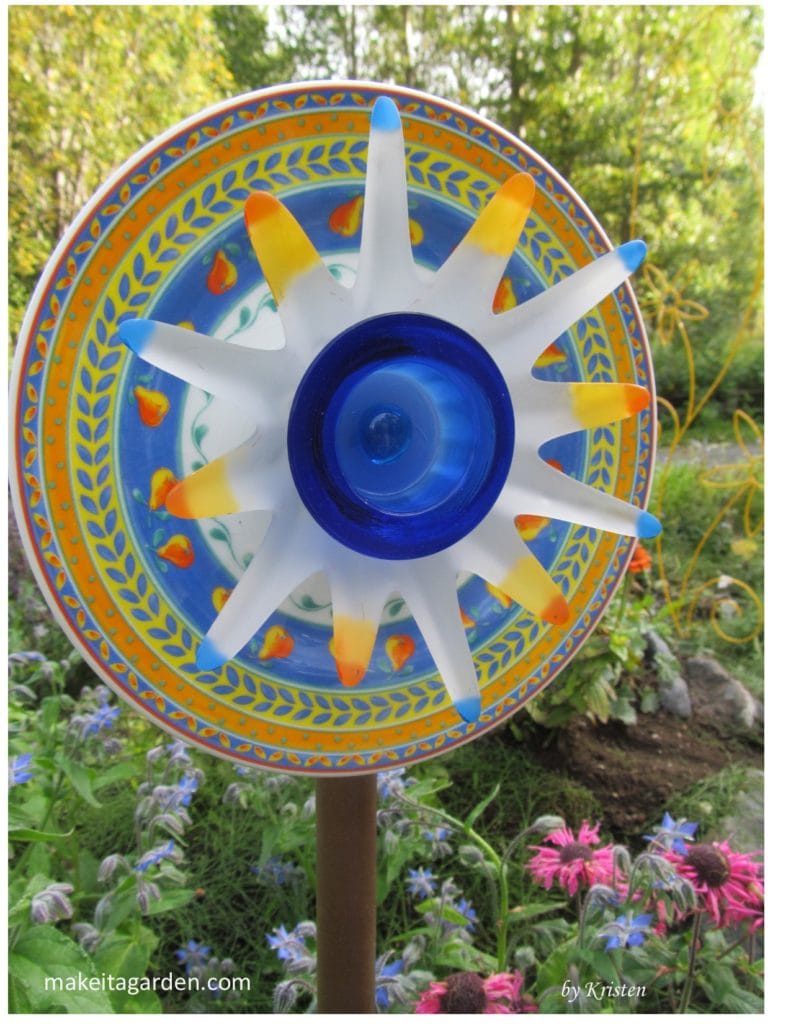
When you engage in a craft where each item you make is original and distinct, it boosts your imagination and creativity. That’s when you begin to put your own signature mark on things that make your dish flower designs stand out.
Benefits of sticking with your niche
If you decide to make and sell your dish flowers, I encourage you to keep at for a few years. Why? Because you’ll become more skilled. The artistic value will noticeably improve. You’ll become an expert with glass and ceramic.
Beyond that, it’s good for business. If you stick with it, you’ll learn a lot about how business works. You’ll make new connections. Your reputation will grow naturally. Your handiwork becomes more recognizable. So, when people think of garden art or dish flowers, they automatically think of you!
Is there a market to sell your dish flower?
One does not go into business without market research. But when I was first starting out, I couldn’t find any information. I didn’t know about Etsy or Pinterest at the time. So, I just figured I’d find out sooner or later. What did I have to lose? Fortunately, making a small number of dish flowers is not a major financial investment.
Back to the question ‘is there a market for dish flowers?’ The immediate answer is YES! The handmade market is hotter than ever. Even Amazon is selling handmade. But garden and outdoor living trends are equally as hot.
Want further proof? New words such as “stay-cation” and “holi-stay” have entered into the vocabulary. That means homeowners are taking an interest in making the backyard or garden a more comfortable and inviting place to hang out. Which includes things that contribute to the ambiance of a setting…like art!
Dish flowers are whimsical. They fit into the re-purpose/up-cycle, vintage and flea market niches, all of which are still going strong.
Are dish flowers still popular?
But, you might ask as I did: are we at the beginning, in the middle or at the tail end of a trend? The fact is, that some trends last for a year or two; others have a much longer staying power. (think Shabby Chic!).
I mentioned previously that I attempted to research this. I found posts dated back to 2008 with discussions on issues makers were having with the dish flower. As for its history, I also haven’t been able to find anything. I’ll take a wild guess and suggest it all started when a farmer nailed an old metal pan to a stake during The Great Depression and stuck it out in the garden.
As for the modern dish flower, it’s hard to say when it actually started. I do know that it takes a while for an idea to gain momentum and get exposure, let alone be a viable item to sell. It takes enough crafters to make them, sell them at craft shows and get photos spread around on the Internet.
It’s my personal observation that dish flowers are still popular and strong sellers. Even so, you should still attempt to research your own market if you intend to sell them locally. I’ve heard that in the Mid-West, dish flowers are so popular that one could find three vendors at any given craft show. Yet, in other areas, you could find people who have never heard of them.
More factors to consider
Not a saturated market Although dish flowers have been around for a while, the launch of Pinterest in 2010 really helped to create a market for the cheerful and whimsical garden art. For that reason, I don’t believe dish flowers have reached their peak yet. I base that opinion on some of these factors below.
Not an easy DIY Dish flowers are not the easiest craft to reproduce at home. It’s something people prefer to buy rather than make themselves. And compared to other crafts, there’s not nearly the same level of competition. Take jewelry, for example. As far as dish flowers are concerned there will be far more buyers than makers.
Not available at Wal Mart Here’s another significant reason to sell dish flowers. There’s no duplication of the item in mass production. Many so-called “crafts” that resemble hand-made are sold at Wal Mart and craft stores like Michael’s and JoAnn. Not dish flowers.
To the best of my knowledge, dish flowers are folk art, and exclusively handmade crafts. The only way to get them is to make one yourself or buy one. Either on line, or from a vendor at a county fair or craft show.
Who buys dish flowers?
It’s important to identify your primary target audience. When you know who your buyer is, you’re better able to sell to them. You’ll get a better sense of which craft shows to do where you’re certain your audience will show up.
More importantly, you’ll be better able to relate to them on a personal level when you know who your target audience is. You are providing your customer with something that will add beauty and value to her yard or garden.
When I first started selling dish flowers and other glass garden art, I had no idea who my audience was. I was content to figure it out as I went along. And while it all turned out ok, an article like this one would have been extremely helpful in giving me more confidence knowing in advance what to expect.
By the time I started the ‘Make it a Garden’ blog I had a pretty good idea of who my audience was. Pinterest only confirmed it through their analytics which is made available to business accounts.
Customer profile
The profile of the typical dish flower buyer:
- Women
- Age: 50+
- working, semi-retired, fully retired
- professional
- middle to upper-middle class
- garden hobbyist, especially flowers
- likes Shabby Chic, vintage, and flea market decor styles
- Likes whimsical, unique garden art
- Has at least one craft or hobby they like to do
Are you surprised?
Essentially, you’re selling garden art to women who now have time for home and garden pursuits. The women who buy dish flowers like things that are pretty and one-of-a-kind. And they’re willing to pay a bit more for a beautiful, well-made piece of garden art that they can’t get at a box store.
Sell your dish flower sculptures in-person
The best place to encounter your audience is in-person at a craft show!
As much hoopla and fanfare as on-line selling gets these days, comparatively, there’s still really not a huge shift yet. And yes, some people sell their dish flowers on E-Bay or Etsy. But they’re not making a whole lot either. At least not to the degree they might have you believe. The reason is because a lot of your target audience still primarily shops retail as opposed to on-line. Even more so when it comes to crafts.
Your typical customer may indeed have the latest smartphone device and be on social media–mainly Facebook. But they still don’t use the Internet to the degree a younger generation does. Not your dish flower crowd. They enjoy going to craft fairs, thrift stores, and garage sales.
I observed something quite interesting when I first started selling my dish flowers. When someone would walk by my booth and spot the dish flowers, it brought an instant smile to their face. A sense of the whimsical does this naturally, I think. And people are drawn to their uniqueness.
I love how my dish flowers make people happy, even if just for a moment. That’s valid marketing information, even if it didn’t result in a sale.
Building Trust
I hope you can see why its important to know your audience. It affects your sales techniques and your promotional materials. Most of all, the intrinsic value of putting a face on the art. When people can know you and interact with you, it builds trust.
When you sell your dish flower sculptures in-person, your buyer will see the exuberance you have for what you make. Bet you didn’t know your personality was a marketing tool! You will, in turn, benefit from their reaction to your artwork: joy, surprise, laughter, curiosity. You’ll benefit from the types of questions that’ll be asked many times over. The customer will buy from you again and tell their friends.
Choosing the right craft show
I can’t tell you which shows to do, or not to do. There is always a hit and miss experiment that’s normal for anyone’s first few years of doing shows as you learn what works and what doesn’t work for you. What I can do is make recommendations on the types of shows that lend themselves to dish flower garden art.
Thankfully there’s one show you can pretty much always count on: the Garden Show! After all, that’s your primary audience! Even if it’s a small one, these are the ladies who love garden art. They know what dish flowers are and will be in a happy, garden “mood” that helps contribute to sales.
It goes without saying that Spring and Summer months are the best times to sell garden art. (Scroll down for more on selling at Greenhouses and Boutiques)
Do your best to research your local market. Know where other artists are selling dish flowers. Go to some county fairs, festivals and craft shows. Is there more than one vendor selling dish flowers? That will give you a sense of the market for dish flowers and you can check out the competition in your area as well.
Shows that attract your audience
In my experience, shows that appeal to a younger crowd and shows that are 50% or more made up of Direct Sales (Scentsy, Paparazzi, LuLaRoe, Color Street etc), haven’t been the best matches for garden art.
I wasted time and money at craft shows that were not profitable, and some of them were ‘popular’ shows. Just not my audience. It’s disappointing to have low sales after all the time and hard work that went into doing a show. Dish flowers and glass garden art is not the easiest to lug around.
We try to make ourselves feel better by writing off a poor show as “good exposure”. But if it’s not your crowd, it’s not “good exposure” either.
There’s a lot of variables, so I can tell you it’s not always easy. None-the-less:
1) Try to learn which shows would attract an audience for handmade garden art. (keep your buyer profile in mind)
2) Try to determine which shows or events are those where people come to buy, not just look.
Good ones to try are Vintage shows with up-cycled or re-purposed furniture and crafts. And of course Garden & Art events. (Scroll down for Christmas Shows)
Circumstances that affect your craft show
Don’t blame a show when there may be a valid reason for low turn-out. Even the best events can’t control nature. You could be at what is typically a good show, but because its raining cats and dogs, attendance is down and so are your sales. An indoor show can suffer, too if it’s snowing like a banshee and no one is going out when the roads are bad.
The first year I had a booth at a garden and art festival, it rained. But those first few hours were not too bad weather-wise. I sold $250 worth of art, until the rain really started to come down steadily. Yet, I knew it was a show worth doing. So, I signed up the following year. That day was as perfect as any could get! A nice day always brings out the crowds. I sold almost triple the amount of garden art.
Finally, the size of the show and the fee amount for booth space is not always a good indicator. A cheap show that attracts your primary audience will pay off. Forking out the big bucks for a 3-day event that attracts gobs of people isn’t worth the time and effort if it’s not your audience, or the right location or the right season.
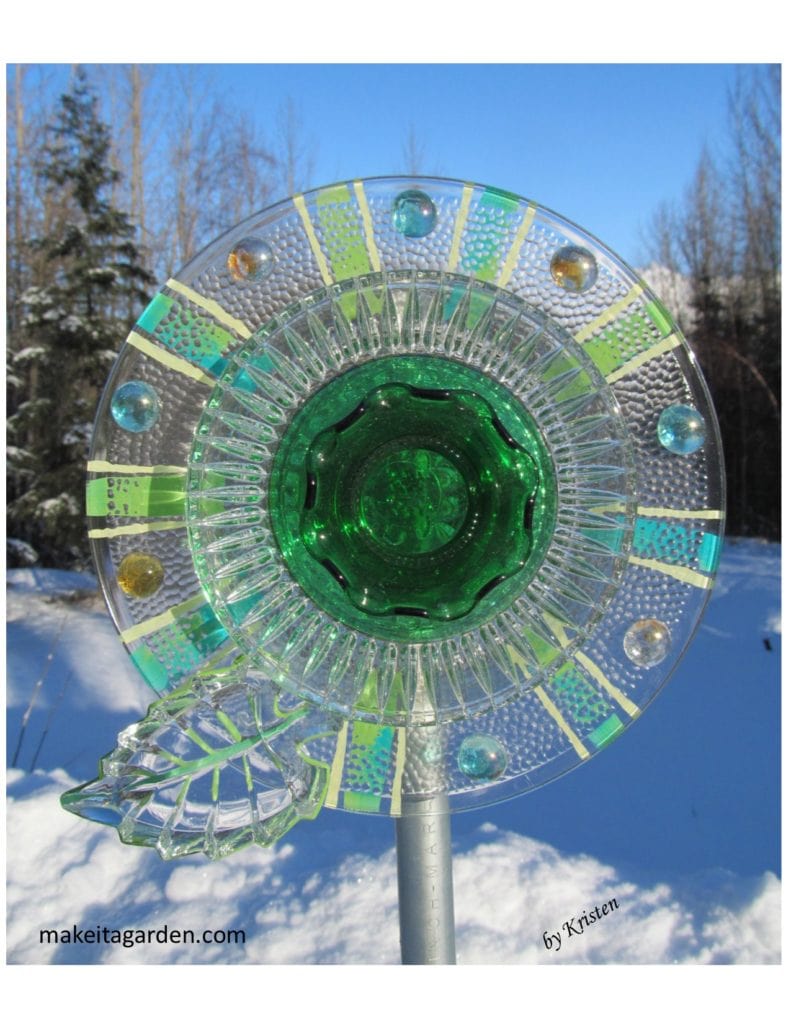
Sell your dish flower art off-season
Trying to figure out where and when to sell your dish flower art (outside of Spring/Summer) sometimes feels like rolling dice. An event that seems like a good one can turn out to be a flop. On the other hand, an event you didn’t have high expectations for can be a pleasant surprise.
But here’s what I’ve experienced selling garden crafts in the off-season: Fall shows in Sept/October can be slow. They may attract an audience, but it’s usually lookers and not buyers. I even tried to sell dish flowers using muted fall colors and plates made to look like sunflowers, but it just didn’t work. People are wrapping up their lawns and garden for the season. The interest to buy isn’t there.
I do have one exception though–a craft show held at a hospital in October. It’s a small one, but I do fairly well at it. So, like I said, you will have to do some experimenting. Perhaps your market may have different practices if you live in a part of the country where it doesn’t snow.
Holiday selling
It’s funny, but again, when I first started selling my dish flowers, I had no idea if a “garden” item would sell in winter. And I live in a cold and snowy state, so naturally I had my doubts. But as it turned out, my most profitable show of the year is during the Christmas season.
We associate dish flowers with the garden and summertime, but believe it or not, they often sell better at holiday craft shows! They make wonderful Christmas gifts and someone always knows someone on their list who loves dish flowers. Someone’s Mom, grandma, wife, or best friend. The flowerhead is removable from the post so it can be wrapped in a box for gift-giving. Be sure to tell customers that!
Another reason to sell your dish flower art at Christmas is because a lot of people will not see it at any other time of the year. People camp or go on vacation during the summer months. The only time they may ever see dish flowers for sale is at a holiday craft show! So, they’re going to grab the one they like and put it away for next summer.
Christmas Craft Shows
Certain Holiday fests and craft shows shows can absolutely be winners, but pick them wisely.
In my first year, I did lots of little shows from church bazaars to school fund-raisers. I had myself scheduled every single weekend from November to mid-December. The end result was dismal at most of them and I was frazzled.
I’ve since come to realize that when it comes to selling dish-flowers for Christmas, the shows most worth doing, are the bigger, more popular ones that attract people who come to buy! These are the annual events that many look forward to each year. They have a tremendous reputation among shoppers for having high-end food and crafts.
As you can imagine, the competition is fierce for Christmas selling. It’s a little tricky because you’ll need to make decisions months in advance. Applications must be returned early just to vie for a spot in one of these shows.
It’s harder to land a spot at one of these, too! Many of them give preference to returning vendors and thus have fewer openings. Booth space sells out quickly. Some makers have tried for years to get in. But you never know, you just might get lucky!
Juried Shows
Some shows are juried shows, and you have to apply to get on the schedule. A panel of judges will review your artwork and approve you for the show. There are not too many craft shows that do this. A juried show is usually a long-running event that has a huge attendance.
The show’s organizers have high standards. But this is good! A juried show typically means it’s exclusively handmade. And then, only artisans that make finer, higher quality handmade crafts that attendees have come to expect. Organizers also want to ensure a wide variety of crafts which means less competition for those selling the exact same thing.
The good news is that dish flowers are totally unique and not a lot of crafters make them. That means your chances are very good at getting into one of these shows! Much better then if you did jewelry, quilting, or knitting. This is why the show earns its high reputation among shoppers who come early to get “the good stuff”. They know this particular show has the best artisans and crafters. And you’re among them!
Best way to display dish flowers
A lot of crafters start out displaying their dish flowers in heavy buckets of sand. I was no different. After hauling them around and lifting them in and out of the car, it’s not too long before you’re looking for better alternatives. My back hurts just talking about it.
Dish flowers are fragile and top-heavy due to the weight of the plates. Standing 5 feet tall out of a bucket is not as secure as it seems. A strong gust of wind can catch the flowerheads like a ship’s sail and send the whole lot crashing to the ground. That really happened to me, one year.
There’s no way to anchor the art piece in the ground like it would be in someone’s garden.
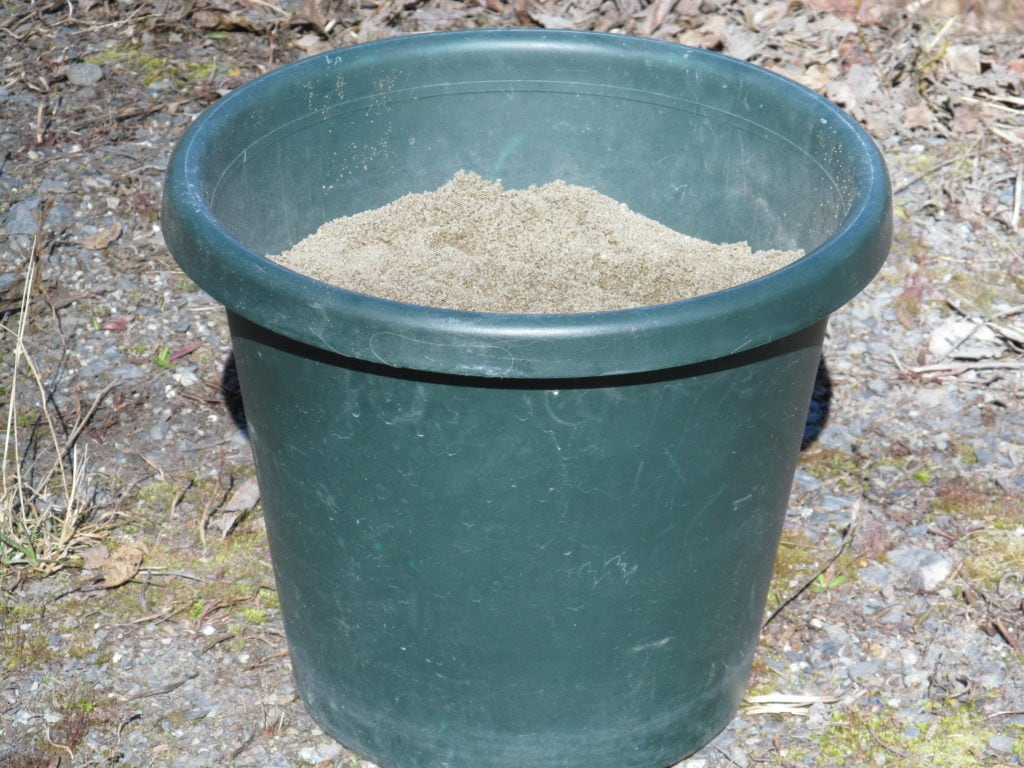
An ideal solution to show off dish flowers

While researching on line, I discovered a fantastic (and cheap) solution. Another dish flower maker showed how she displayed her dish flowers securely. No construction required! She used a 2×4 plastic folding table from Wal Mart and cut 1″ holes through the top. If you have a battery drill at home, you can buy a separate hole cutter attachment for it.
The table holds the flower stem halfway up so it’s good and secure. In an outdoor setting, you can put a weight like a sandbag over the table legs for additional security. The tables are much better for transporting than the buckets. They are lightweight and lay flat in the back of your vehicle. You can put totes or boxes on top of them.
The Display that gets best results
I always display my dish flowers on the post (rather than off) because it helps people recognize what they are. They’re more visible on the post. They can be spotted from a distance. And they stand at a height that’s close to eye-level. They display the way they will look in the garden so a prospective buyer can get a better idea of how the art piece will look at home.
Because they can be more problematic to set up, some vendors lay their flowerhead pieces on top of the table. They’re less visible and when people see them on the table, they are less likely to recognize them as a ‘dish flower’. I watched a fellow maker have to explain what they were, describe how they are set up, retrieve a bare post to demonstrate it to the customer. That’s a lot to go through!
It’s so much more beneficial, from a sales perspective, to have all your dish flowers up on the post. Together in a grouping, they look so whimsical and cheerful.
When dish flowers are easy to see, you don’t need a big sign. They advertise themselves! You won’t need a tablecloth either. But DO add some decoration to your display.
Decorating your booth
I use a cheap picket fence (Lowes) or a section of white plastic lattice (also at Lowes) to cover the front of the table. The fence and lattice are things that people associate with “garden”. I’ll accent my booth with a plastic watering can, garden gloves and small garden tools or a wooden ‘garden’ sign. It helps to convey “garden” for those who have never seen dish flowers before.
How many dish flowers should you take to market?
How many art pieces to bring depends on what you have room for. Keep in mind that booth space for most shows is quite small. You won’t typically have room to spread out, unless you pay for a large space or two side-by-side spaces.
Bring as many as you can and a good variety to appeal to different tastes and favorite colors. My “special tables” hold 12 dish flowers each for a total of about 24. If I have more than that, I keep extras on hand under the table, but 24 is about the limit I can creatively pack into my SUV.
Because dish flowers are large, bulky and fragile you have to use bubble wrap or other packing materials to cushion them so they don’t get damaged. That’s why taking 24+ dish flowers to a show takes up so much space. Depending on your needs at any particular craft show, you can always come up with a good friend or family member to help transport your load and get things set up.
Other things to pack for the show
I bring a small spray bottle with water and soft cloth so I can clean or dust dish flowers to improve their sparkle. Sparkly sells! Try to trouble-shoot. Have extra price tags and business cards on hand, too. Keep wind and rain in mind if doing an outdoor show. Bring any tools you might need to put your display together or make an easy repair.
Scissors, scotch tape, gorilla tape, extra pens and such are useful to have on hand to help a fellow vendor. Bring a small notebook to record inventory and sales.
Bubble Wrap to wrap the customer’s purchase.
Helpful equipment to have
I purchased a little fold-up canvas cart to safely transport my things from the car to my booth. There are many different models, but mine is made by Ozark Trail. (Wal-Mart) For around $40-50 bucks. It’s quite strong and sturdy. It even handled my heavy buckets of sand!
There are other devices you can use, but I love my little cart and enthusiastically recommend it. Best of all it folds up super compact like a small tent and doesn’t take up much space in the car.
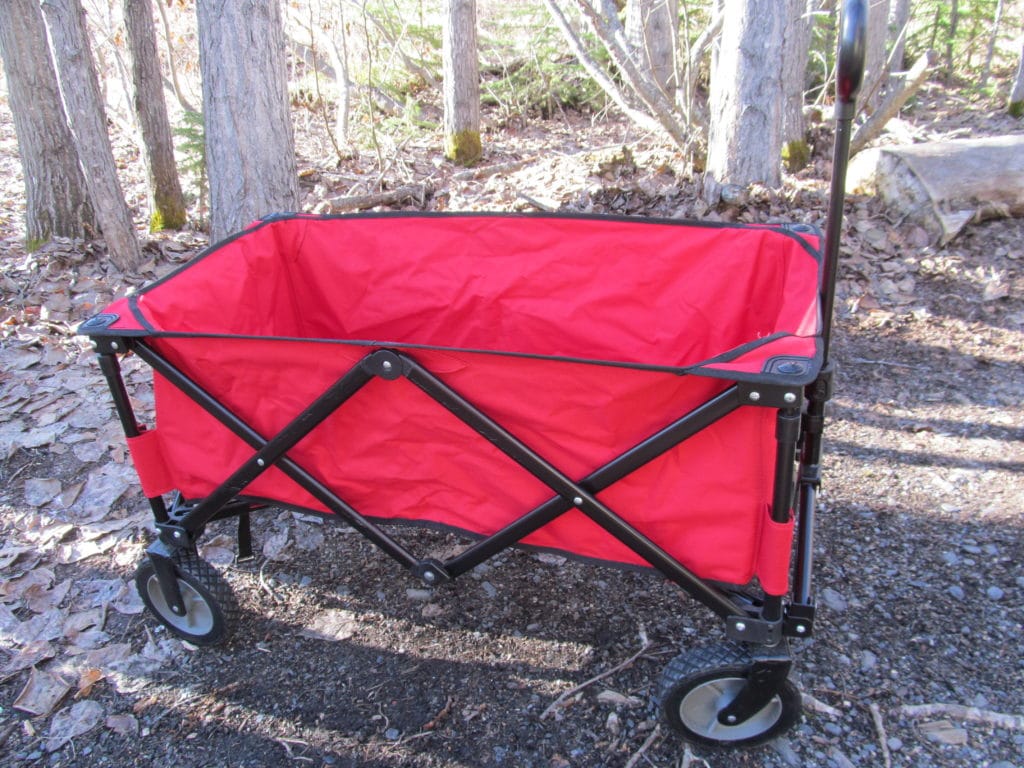

What about the Competition?
Competition between vendors is an interesting thing. In your area, there may not be anyone else selling dish flowers. As popular as they are, few people actually make them. It’s kind of nice to attend a show and be the only one. You have no competition what-so-ever!
That was my case for the first two years. Then, I ran into a couple from the next town over. We were vendors at the same garden and art fair. One year, the fair organizers stationed us just five booths apart. I could tell people were comparing prices and that made me anxious.
Although they did beautiful work, the construction was quite different so it wasn’t an apples-to-apples comparison. For one, I drill my plates. The other couple glues a spoon on the backside. They also use the cheaper aluminum for the stem, while I use galvanized conduit. Mine require a lot more work.
Without mentioning the other vendor, or their product, I confidently described the materials I used and spoke of how secure the drilling technique was. Never, ever bad-mouth another vendor. Your customer won’t appreciate it and may even pass along your negative comments.
Be professional with fellow vendors
Instead, speak kindly of your competitor. Though their artworks may not appeal to you personally, they might to the customer. At a minimum, you could say “he’s a nice guy”, or “she does good work”. You’ll be surprised at what a difference it makes.
Your personality and character DOES have a role. Some people will buy from you simply because they like you! To sell your dish flower art, you don’t need to be defensive if you are confident of your product.
Let’s face it. Customers don’t know the difference. Two dish flowers can look like exactly the same thing. So, it helps to really promote what you feel are the strong points of your garden art. The quality of construction, materials used and of course the artistry. If you use an antique dish, mention it! It’s a good selling point. People love little tidbits that make their garden art extra special.
What about the “other vendor” I mentioned above? I took a big step out of my comfort zone and went over to introduce myself. I even complimented them on their work. They were very friendly and welcoming towards me, their competitor. At the end of the day, my car battery died. Who showed up with jumper cables to save the day? The fellow’s wife!
How to respond to questions
As a vendor, you’ll be asked certain questions over and over again. You can allow it to make you weary, or you can let it become a potential sales point. Treat every question as if its the first time you’ve heard it.
Yes, it consumes a lot of energy to smile and make small talk. It wipes me out at the end of the day. But it really does make a difference in how you represent yourself and your art. People really do remember you!
Since I’ve been selling my dish flowers, the two most common questions I get are these:
1) Do they spin?
2) What glue do you use?
“Do they spin?” That’s the question asked by people who have never seen them before. They’re thinking of the little flower spinners they see at the store or in someone’s yard. To them, the dish flowers on a post look like they might turn. I try to use humor, but then tell them why they don’t spin.
“What glue do you use?” is another common question. It’s asked by women who have seen dish flowers and know what they are. They might have tried to make one themselves at one time. Often the wrong type of glue is used and the dishes fall apart.
Use questions as a selling point
Address the glue question (or any other question about your method) as a selling point. There’s two reasons behind the question. One, the prospective buyer wants assurance that your art piece will hold up. Or two, maybe they’ve always wanted to DIY, but didn’t know what glue to use.
Your answer is perceived as very helpful information because the maker is the expert, right? Even if they do not buy one, they’ll remember that you were very helpful and informative. Always remember your customer profile. Some of these ladies aren’t too good when it comes to looking things up on the Internet. Never tell someone to just look it up! BE their SOURCE! That’s a very positive selling point!
Now, then, what about negative comments? What about the person who asks “Where do you get your plates?” If you’re like me you quickly reply, “I get them at thrift stores and garage sales”. Most of time, that question is purely innocent.
But I’ve also noticed that occasionally, there’s a hidden negative beneath the surface. The person asking the question already knows the answer. They know you get your plates for “pennies”. They are appalled by the price tag on your artwork (though they won’t come right out and say it). Be kind to them also. They are the few who clearly don’t understand or appreciate the artistry that goes into making one-of-a-kind dish artwork.
Retail: consignment vs wholesale
Some garden art makers tire of the craft show routine. Some simply may not wish to do it at all! There’s still a way to sell your dish flower art. Have you considered trying retail?
You may know of shops that seem like a good match for dish flowers. A local greenhouse that also has a gift shop is the best place to start. (Remember your target audience!) Then, small boutiques. It’s easier to start local because you can deal personally with the store owner, and get some experience, too. Locals who shop there will become more familiar with your art. Selling in stores opens up a whole new doorway to you as an artist.
A shop will offer one of two approaches: Consignment or wholesale. Consignment means you get paid after your items have sold. The split on the low end is 40/60 (40% shop, 60% artist). On the high end 75/25. I’ve even seen it 80/20 (80% to artist) at a greenhouse that valued featuring local artists, and less concerned with profit.
Wholesale means selling your art at a reduced price. Sometimes as much as half of what you’d sell it for at a craft show. The retailer will double the price plus a dollar or two more. But you get paid upfront and you’re free of any further obligations.
Social Media
You do not have to use social media to succeed in selling dish flowers. I’m not a big fan of social media, personally, and I wasn’t on Facebook prior to selling my garden art. But I had so many customers asking if I had a web site or was on Facebook. I decided it might appear more professional and build trust to have a business page on Facebook.
There’s no cost to set up a business account on Facebook. Many artisans and crafters use Facebook as a cheap and effective substitute for a web site. It offers a place on line where you can display your artwork and artist profile and promote your shows, all FREE.
You do not have to buy ads. In fact, for the ‘little guy’ like you or me, Facebook ads aren’t all that effective. I’ve never once encountered anyone who said they learned about me on Facebook. The classic ways of marketing still work. Especially with older audiences.
Business cards
I would like to share one hugely effective tip on Business Cards. Should you decide to use business cards: Put your dish flower image on it so people remember what it is you make.

When your card says “Mary’s Designs” or “Over the Rainbow”…without an image, or description, people won’t remember what that means and toss the card away. If it’s too costly to have a color photo, at least have a description in large print: Handcrafted dish flowers and glass garden art.
That way, when they find your card at the bottom of their purse or in their coat pocket, they’ll instantly be reminded of you and your artwork. They may keep your card around longer for reference.
Final thoughts
Perhaps there was more than you realized to sell your dish flower art. It certainly has its own special set of challenges, it’s own market appeal and unique customers. I don’t know if others have written on this subject lately, but I hope it fills a void.
There are associations for people who do certain crafts that share information and advice. I couldn’t find anything for artisans who make and sell dish flowers and glass garden art. So hopefully this article will start some discussion.
The primary ideas I hope you’ll take-away from this are: 1) Know your customer
2) choose your craft show venues wisely
3) YOU (unique personality) are an asset and selling point just as much as your art.
I invite you to leave a comment below and value your feedback. We can benefit from helping one another in the process. So, go sell your dish flower garden art with confidence!
More dish flower topics for you:
How to drill a hole in a plate
Selling Christmas-theme dish flowers
The form you have selected does not exist.

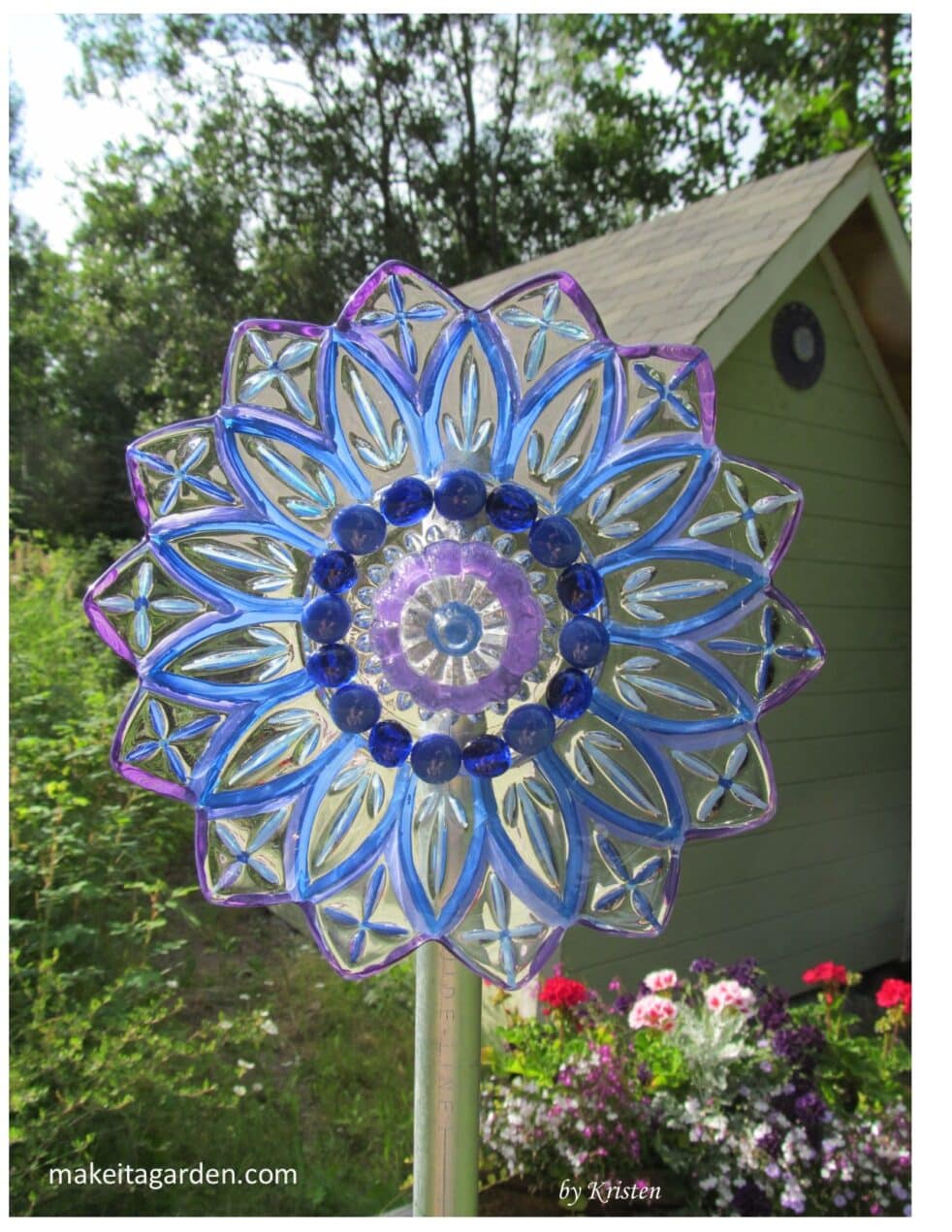
Bravo! Great all-inclusive article for the potential dish flower creator! You inspired me to try my hand at this craft and I did a simple bird bath with a glass vase and a unique ceramic plate. I’ll send you a photo of it. Feel free to use it on your blog.
Thank you, Lorna. Can’t wait to see what you made!
This article was awesome. I have just started to make my flowers and I love it. I finally signed for a show and hope it goes well. Thank you for all the information.
Thanks so much for the feedback, Doris, I can’t tell you how much I appreciate it. It helps me know if I’m hitting the mark. I truly hope your show went well and that you had good sales. I happy to answer any further questions you might have. ~Kristen
I started making dish flowers this summer when a friend introduced me to the craft. I am obsessed with it and I love it! Haven’t sold any yet! Tried Facebook…no luck. Selling cheap too. Your article was fabulous! So much great information. I love the way you displayed the plate flowers. Much easier than pots! Thanks again for all the information! Carol Burn from DE
Thanks so much for taking the time to post a comment, Carol! I’m so glad to be of help. It’s a big part of why I have this blog/web site. Did you use Facebook Marketplace? It’s like Craig’s list, only on Facebook. Fall can be a slow season. But try again after Thanksgiving because people will be looking for Christmas presents. You might also try the “handmade” or local crafters FB groups for your town. It’s free to join the group(s) and you’ll allowed to post your crafts for sale. Last year, a lot of shows were cancelled due to covid, and I actually did pretty well selling things on FB Marketplace. Also make sure the photos are good. Try to photo in good light (outdoors if you can) or maybe at a local greenhouse. Quality photos make a big difference in how your art looks online. So, don’t give up be encouraged!
Thank you so much for your kind reply. I love love making the flower plates but am very discouraged about selling them. I’ve been to one craft sale and it was a bust. Am still trying but so low. Have tried Facebook marketplace where I usually have success. No luck yet. Wish I could send a picture of my work.
Thanks Carol. As I mentioned in my article, it can be hit & miss to figure out which shows attract your audience. Marketplace helps b/c you can target the garden crowd that is most likely to adore whimsical garden art like yours. Lately, I haven’t sold anything on marketplace either, and the ones I posted are usually my best sellers..the glass ones. I think it has more to do with the economy. Summer is winding down. But the holidays are coming and people may purchase an artwork for the gardener on their list. Hang in there! ~ Kristen
Love all your input! Thank You so much! Wishing you continued Success🎨artist!
Linda, thanks for taking the time to give feedback…it’s valuable to me. I’m so glad the article was helpful, that’s why I do what I do! Wishing you lots of success..and have fun while you’re at it! – Kristen
How do you decide a price to sell??
Excellent question…and I’m planning on doing a post on this topic as well. There are 2 basic formulas that some artists use. 1) $25/hour (professional rate…probably $35 now!) however long it takes you to make one. 2) cost of materials x2 or x 3. If you are just starting out, you might want to have slightly lower prices to entice people to buy from you so you have a customer base, and you’re introducing yourself as an artist. But, once you’ve been at it for a few years and you’re more developed as an artist and the quality of your work improves and you’re starting to become known in your area for your particular art form…you can justify higher prices (prices not based on a formula) and customers will pay it b/c you’ve built up that trust and name recognition and sterling reputation. Also…be aware of the economy. Right now,(Aug 2023) it’s increasingly difficult for some people with higher food, gas and home utility costs…especially those on a fixed income. It may vary depending on the area you live in. My sales were down a bit this year, and this is likely the reason. Hope this help. Feel free to contact me anytime! Kristen
Thank you sooooo much! I am really enjoying all you posts!!!!
You’re welcome! I really DO try to provide the most helpful content and freely share my knowledge and experience. Thanks for visiting Make it a Garden.
Thank you for the information. I’m doing my first craft fair this Saturday. This may be a bad idea, but I have tried the PVC pipe and they didn’t work so I got wooden dowels and painted them green for stems. I haven’t seen anyone using them so I’m wondering if it is a bad idea? It was alot less expensive, I had to buy 40 of them and they were easy to work with. Have you ever tried them? I figured if anyone buys flowers they can get a metal pipe.
Thank you for your informational posts. I am currently making these as a hobby and I given them as gifts. One question that is asked is if they can stay outside in snowy winter weather or if they should be brought inside during the hash months? Also I have been asked if the sun will fade ceramic plates? Do you know the answer to these questions?
Regardless of the method of construction, the flower head is always made to be easily removed from the post for storage over the winter. Then re-attached to the post in summer, w/o having to re-install the post. If solid (meaning not too fragile) pieces are used on the dish flower, most glass and ceramic plates can handle the cold. I left a couple out one year as a test and I live in a winter state. But they may be more at risk of damage from high winds, rocks or chunks of frozen snow tossed by a snow plow, icicles or snow falling off a roof (if the flower bed is next to the house), so for that reason, I always recommend storing the flower head in the shed or garage. As for ceramic plates fading…I have not experienced that myself, but we have rather mild weather in my state. Ceramic plates are sealed to make them suitable for food and to withstand rigors of normal use (dishwasher, microwave etc.) I’ve never heard of them fading. In fact, this is the first time I’ve had that question. Melamine and other plastics fade easily, but not ceramics. If someone has seen a plate that looks faded, it’s b/c the plate has seen a LOT of use. Lots of scrubbing, knife scratches from cutting food…maybe a restaurant plate and the sheen has worn off, but not the color.
Loved your article! I have been making dish flowers, solar mushrooms and bird feeders for the last year.
It started as a hobby after I retired but I am interested in growing and trying to sell some also and this really helped! Thank you
Thank you so much for sharing your experience and advice. I’m about to sell my glass flowers at a holiday bazaar and you answered my most pressing question, how to display them.
Exciting! Hope it goes well for you!
Phenomenal article 👏 🙌 Thanx for sharing this valuable information, it included things I hadn’t taken into account, I now feel confident to give this a try now that I am “armed and dangerous ” with more knowledge ‼️
Wishing you all the best. If you have further questions, let me know and I’ll try to help!